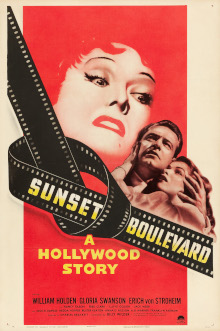- Franz Waxman
Sunset Boulevard: A Sonata for Orchestra (1950)
- Sony / ATV Songs LLC (World)
arr. John Mauceri
- 2(II:pic).2(II:ca).3(I:asx.II:Ebcl.III:bcl,tsx).2(II:cbn)/3[+3].3.3.1/timp.2perc/pf(cel).hp/str
- 14 min
Programme Note

Although film scores from the classic years of sound pictures sometime fill as much as 90% of the running time of the film, the musical sequences were not intended to be played in concert performance and therefore must be adapted if one is ever to hear this enormous symphonic output in live performances. Occasionally the composers had the time and the opportunity to create concert works themselves (Waxman’s A Place in the Sun, for example), but usually the thousands of hours of music created for the cinema remains only as photocopied scores at university libraries, unavailable to orchestras and only heard partially buried under dialogue and sound effects — assuming one can see and hear these films at all.
As an experiment (and remembering that composer Max Steiner credited Wagner for inventing underscoring) I assembled the complete original score to Sunset Boulevard in the hopes that one could stitch together various musical cues and create at the very least a set of themes and variations. After some weeks it became clear that the score — which includes a wildly energetic chase theme (appropriate to both principle characters), a jazzy theme for the young writer Joe Gillis (William Holden), and a tango for the aging silent film actress, Norma Desmond (Gloria Swanson) — might indeed have all the elements of a sonata, i.e., an exposition of at least two contrasting themes, a development section, and a recapitulation of the original themes. Indeed, the music which underscores Joe Gillis’ attempt to leave Norma, which culminates in his murder, is in fact a slow-motion recapitulation of the opening chase theme, and both Joe’s and Norma’s themes are repeated in the last musical cues of the film.
Sunset Boulevard: A Sonata for Orchestra includes only the original music and orchestrations from the Academy Award-winning score. It tells its story much as Strauss tells of death and transfiguration or the merry pranks of Til Eulenspiegel — and that should come as no surprise. Composers of Waxman’s generation were well-trained composers first and the film soundtrack was simply their preferred medium, like opera was to Wagner and instrumental music was to Brahms.
Sunset Boulevard: A Sonata for Orchestra was recorded by the Hollywood Bowl Orchestra on Philips Classics (“Hollywood Nightmares” 442 425-2) and received its world premiere performance at the Teatro Nacional de São Carlos in Lisbon with the National Orchestra of Lisbon on May 1, 1994, both under my direction.
— John Mauceri

 Located in the UK
Located in the UK
 Located in the USA
Located in the USA
 Located in Europe
Located in Europe
